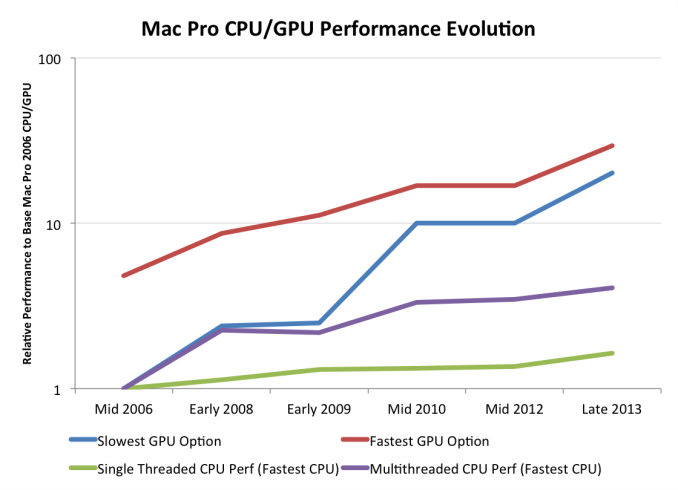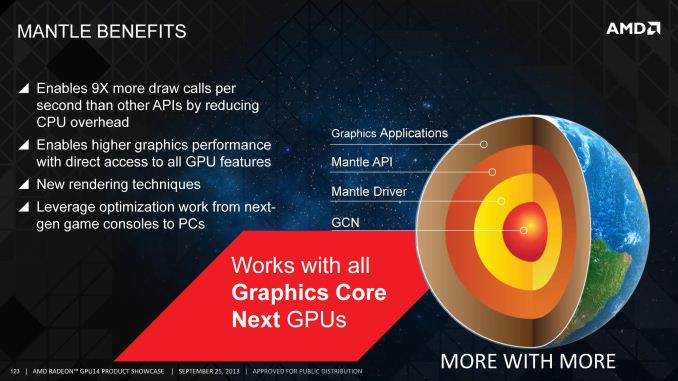Microsoft Announces DirectX 12: Low Level Graphics Programming Comes To DirectX
by Ryan Smith on March 24, 2014 8:00 AM EST
With GDC 2014 having drawn to a close, we have finally seen what is easily the most exciting piece of news for PC gamers. As previously teased by Microsoft, Microsoft took to the stage last week to announce the next iteration of DirectX: DirectX 12. And as hinted at by the session description, Microsoft’s session was all about bringing low level graphics programming to Direct3D.
As is often the case for these early announcements Microsoft has been careful on releasing too many technical details at once. But from their presentation and the smaller press releases put together by their GPU partners, we’ve been given our first glimpse at Microsoft’s plans for low level programming in Direct3D.
Preface: Why Low Level Programming?
The subject of low level graphics programming has become a very hot topic very quickly in the PC graphics industry. In the last 6 months we’ve gone from low level programming being a backburner subject, to being a major public initiative for AMD, to now being a major initiative for the PC gaming industry as a whole through Direct3D 12. The sudden surge in interest and development isn’t a mistake – this is a subject that has been brewing for years – but it’s within the last couple of years that all of the pieces have finally come together.
But why are we seeing so much interest in low level graphics programming on the PC? The short answer is performance, and more specifically what can be gained from returning to it.
Something worth pointing out right away is that low level programming is not new or even all that uncommon. Most high performance console games are written in such a manner, thanks to the fact that consoles are fixed platforms and therefore easily allow this style of programming to be used. By working with hardware at such a low level programmers are able to tease out a great deal of performance of this hardware, which is why console games look and perform as well as they do given the consoles’ underpowered specifications relative to the PC hardware from which they’re derived.
However with PCs the same cannot be said. PCs, being a flexible platform, have long worked off of high level APIs such as Direct3D and OpenGL. Through the powerful abstraction provided by these high level APIs, PCs have been able to support a wide variety of hardware and over a much longer span of time. With low level PC graphics programming having essentially died with DOS and vendor specific APIs, PCs have traded some performance for the convenience and flexibility that abstraction offers.
The nature of that performance tradeoff has shifted over the years though, requiring that it be reevaluated. As we’ve covered in great detail in our look at AMD’s Mantle, these tradeoffs were established at a time when CPUs and GPUs were growing in performance by leaps and bounds year after year. But in the last decade or so that has changed – CPUs are no longer rapidly increasing in performance, especially in the case of single-threaded performance. CPU clockspeeds have reached a point where higher clockspeeds are increasingly power-expensive, and the “low hanging fruit” for improving CPU IPC has long been exhausted. Meanwhile GPUs have roughly continued their incredible pace of growth, owing to the embarrassingly parallel nature of graphics rendering.
The result is that when looking at single threaded CPU performance, GPUs have greatly outstripped CPU performance growth. This in and of itself isn’t necessarily a problem, but it does present a problem when coupled with the high level APIs used for PC graphics. The bulk of the work these APIs do in preparing data for GPUs is single threaded by its very nature, causing the slowdown in CPU performance increases to create a bottleneck. As a result of this gap and its ever-increasing nature, the potential for bottlenecking has similarly increased; the price of abstraction is the CPU performance required to provide it.
Low level programming in contrast is more resistant against this type of bottlenecking. There is still the need for a “master” thread and hence the possibility of bottlenecking on that master, but low level programming styles have no need for a CPU-intensive API and runtime to prepare data for GPUs. This makes it much easier to farm out work to multiple CPU cores, protecting against this bottlenecking. To use consoles as an example once again, this is why they are capable of so much with such a (relatively) weak CPU, as they’re better able to utilize their multiple CPU cores than a high level programmed PC can.
The end result of this situation is that it has become time to seriously reevaluate the place of low level graphics programming in the PC space. Game developers and GPU vendors alike want better performance. Meanwhile, though it’s a bit cynical, there’s a very real threat posed by the latest crop of consoles, putting PC gaming in a tight spot where it needs to adapt to keep pace with the consoles. PCs still hold a massive lead in single-threaded CPU performance, but given the limits we’ve discussed earlier, too much bottlenecking can lead to the PC being the slower platform despite the significant hardware advantage. A PC platform that can process fewer draw calls than a $400 game console is a poor outcome for the industry as a whole.













105 Comments
View All Comments
ninjaquick - Tuesday, March 25, 2014 - link
I don't think you realize how much engineers like to tinker. They will use D3D12 and Mantle if they get the time, and will get them to the public whenever possible, so long as development is more fun than frustrating.Scali - Tuesday, March 25, 2014 - link
Well, aside from the 'tinkering' part, it's pretty much a given that D3D12 will become the standard at some point. Why not build that D3D12 now, rather than wait until D3D12 is as popular as D3D11? It will give you a competitive advantage.Same goes for Mantle, to a lesser extent. Having support is an advantage, but it is harder to justify the extra work, because it is AMD-only, and DX12 will probably make Mantle obsolete within 1.5 years.
Anders CT - Monday, March 24, 2014 - link
@ninjaquickWell, then that is a problem. Why would a developer optimize a game using an API that excludes 80-90% of the installbase?
jabber - Tuesday, March 25, 2014 - link
I think I remember reading the same comments when DX10 was announced.I don't think anyone died as a result. The world carried on.
ninjaquick - Tuesday, March 25, 2014 - link
Because developers, contrary to popular belief, are people organizations, with real people working in them. Many engineers love to do what they do and welcome new challenges, and can easily pitch working on something new and exciting so long as they can properly list the risks and benefits.Why would anyone support stereoscopic 3D, even though the vast majority of the population doesn't use it? Because they can.
Homeles - Monday, March 24, 2014 - link
Microsoft's previous API-locking was a software limitation (DX10 requires WDDM 1.0), rather than an arbitrary work of greed, so it mostly depends on whether or not Windows 7's WDDM 1.1 can support it. Of course, there's the support issue that A5 has highlighted as well.lefty2 - Monday, March 24, 2014 - link
Actually, OpenGL has had extensions that bring the benefits of DirectX 12, since about a year ago. That was covered in one of the GDC tech talks. The only catch is that these extensions are yet only fully implemented on Nvidia hardware... but still quite interestingsteven75 - Monday, March 24, 2014 - link
I would like to know the answer to this as well. OpenGL sure seems more important these days.boe - Monday, March 24, 2014 - link
How many FPS was this getting on DX11? 60FPS on DX12 doesn't tell us much for all I know it was getting about 80FPS.Developer Turn 10 had ported the game from Direct3D 11.X to Direct3D 12, allowing the game to easily be run on a PC. Powered by a GeForce GTX Titan Black, Microsoft tells us the demo is capable of sustaining 60fps.
DesktopMan - Monday, March 24, 2014 - link
Yeah knowing that the game runs at 60 when capped at 60 is not informative at all. It should run at 120fps+ on a Titan, compared to the Xbox One GPU.